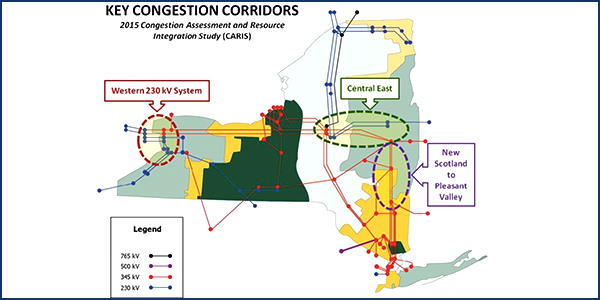By Michael Kuser
NYISO’s Board of Directors on Monday selected two 345-kV transmission projects intended to address persistent transmission congestion in New York and foster delivery of renewable energy to the state’s population centers.
The projects — part of the broader AC Public Policy Transmission Project — address transmission capacity at the Central East (Segment A) electrical interface and Upstate New York/Southeast New York (UPNY/SENY or Segment B) interface.
“The projects will add the largest amount of free-flowing transmission capacity to the state’s grid in more than 30 years,” the board said in a statement.
The board in December issued a mixed decision on project selections made by NYISO’s Management Committee. The MC — along with ISO staff — had backed two joint proposals by North America Transmission (NAT) and the New York Power Authority. (See NYISO MC Supports AC Transmission Projects.) Cost estimates for both projects ranged from $900 million to $1.1 billion.
But while the board accepted the committee’s recommendation for Segment A, it switched Segment B to a competing proposal by National Grid and New York Transco. (See NYISO Board Partially Reverses AC Tx Project Selection.)
The NAT/NYPA Central East project involves construction of a new 345-kV line from Edic to New Scotland on an existing right-of-way; construction of two new 345-kV lines from Princetown to Rotterdam; decommissioning of two 230-kV lines from Edic to Rotterdam; and related switching or substation work at Edic, Princetown, Rotterdam and New Scotland.
The National Grid/Transco UPNY/SENY project involves several different areas of focus, including construction of a new double-circuit 345/115-kV lines from Knickerbocker to Churchtown and on to Pleasant Valley; construction of a new tap of the New Scotland-Alps 345-kV line and new Knickerbocker switching station; and related switching or substation work at the Greenbush, Knickerbocker, Churchtown and Pleasant Valley substations.
The project also entails decommissioning a double-circuit 115-kV line from Knickerbocker to Churchtown and two double-circuit 115-kV lines from Knickerbocker to Pleasant Valley.
National Grid and Transco will also oversee new line traps, relays, potential transformer upgrades, switch upgrades, system control upgrades and the installation of data acquisition measuring equipment and control wire needed to handle the higher line currents resulting from the buildout. The companies also will build a new double-circuit 138-kV line from Shoemaker to Sugarloaf; decommission a double-circuit 69-kV line from Shoemaker to Sugarloaf; and perform related switching or substation work.
“The additional transmission projects selected will improve the flow of power from upstate renewable resources to meet downstate demand and enhance the reliability and resilience of the grid … will alleviate congestion, help deliver power where it is needed most and aid the state in meeting its ambitious renewable energy goals,” interim NYISO CEO Robert Fernandez said in a press release.
The projects are the second and third transmission projects to emerge from the ISO’s Public Policy Transmission Planning Process, a planning activity required by FERC Order 1000 and the state’s Public Service Commission. The PSC identified the public policy transmission needs to increase transfer capability from central to eastern New York by at least 350 MW and from the Albany region through the Hudson Valley region by at least 900 MW.



